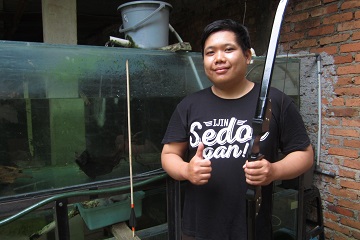The Professor of IPB answers the Problem of Nutrition in Indonesia through Innovation of Mulberry and Catfish

Health is not a static condition but represents a fluid range of physical and emotional well-being continually subjected to internal and external challenges such as worry, overwork, varying external temperatures, mechanical stresses, and infectious agents. It is a process of expanding consciousness that synthesizes disease and non-disease and is recognized by patterns of person-environment interaction. An understanding of pattern is basic to an understanding of health, and involves the movement from looking at parts to looking at the whole. The energy substances (mainly carbohydrates and fats) are the basis and guarantee of life activity, especially the oxidative phosphorylation for energy supply. However, excessive absorption and accumulation of these substances can lead to metabolic diseases such as obesity, hyperlipidemia, diabetes, and cancers. Undernutrition and micronutrient deficiencies contribute substantially to the global burden of disease.
This is what makes everyday human activities affect the body condition including how the diet and quality of nutritional intake received. In addressing nutritional problems, some related factors are among others, high number of poverty; poor environmental health; low coordination of inter sectors and inter program, low involvement of community; poor food accessibility at household level especially for poor families; high prevalence of infectious diseases; inadequacy of mother care; and poor access of families to primary health care services. Inadequate dietary intake and disease – which are the immediate causes of maternal and child malnutrition – are due to inappropriate or inadequate infant and young child feeding practices, frequent illnesses and infections, poor hygiene and care practices. It seems that Indonesia still has a variety of nutritional problems that affect the health condition and quality of human resources.
.The Indonesian habitual diet is high in carbohydrates and low in animal-source foods. Nutrition is very much associated with quantity of food, rather than with quality. The main sources of protein are tofu/tempe and eggs. Some of the nutritional problems encountered in Indonesia are less protein energy, less vitamin A, iron nutritional anemia, more nutrition, and less iodine. Malnourishment can greatly compromise a child’s immune system, making them more susceptible to infectious diseases. During childhood and adolescence, good nutrition and dietary behaviors are important to achieve full growth potential and appropriate body composition, to promote health and well-being, and to reduce the risk of chronic diseases in adulthood. Nutrition problems that occur during growth can affect cognitive, immunity, work productivity, to trigger various diseases. It is the impact of the malnutrition pattern caused by the weakness of the economy and the wrong knowledge about nutrition. In rural areas with poor market access, forests and trees may provide an essential source of nutritious food.
Have you ever thought silkworm pupae contain nutrient rich and can be used as food? Spent silkworm pupae are a waste material often discarded in the open environment or used as fertilizer. Professor of Nutrition of Institut Pertanian Bogor (IPB Bogor
Agricultural University), Prof. Dr. Drh. Clara Meliyanti Koesharto, MSc., developed local renewable food alternatives-based food as effort to address undernutrition. The pupae has been processed into flour and marketed and labeled as Pury and has been patented. This effort is welcomed by the people of South Sulawesi as one of the largest silk producers in Indonesia. So far, silkworm pupae has not been utilized and would become a waste product of silk industry.
The nutrition intervention program conducted by prof. Clara is not a new activity, in addition to utilize the source of protein she also has developed tea from mulberry leaves, mulberry juice, and chlorophyll from mulberry leaves. The focus of her research is the utilization of local materials around the community as improvement of the nutritional quality of foods as a public health tool. "Keeping this in view an attempt was made to explore the potentials of silk and silk-like protein" she said.
Other food sources had been studied by prof. Clara is catfish. Catfish (Clarias gariepinus) at a certain size is not preferred for consumption so they are being marketed. However, the nutritional value of such catfish is still the same, it contain heart-healthy omega-3 fatty acids. Consumption of these types of fatty acids is thought to be associated with reduction in blood pressure and reduced risk for certain cancers, inflammatory conditions such as rheumatoid arthritis, and even mental decline. Seeing the opportunity, she also developed catfish meals as nutritious catfish biscuits as a supplementary feeding (PMT) for toddlers. The catfish biscuits "Biscuit Clarias" the name are given, containing Omega 3 and amino acids are good for human health. You may not have heard so much about the ingredient it contains, omega-6 fatty acids. Like omega-3s, these are polyunsaturated and help lower blood cholesterol levels, however they are thought to play a role in clotting function, are inflammatory and susceptible to oxidation — thereby possibly increasing risk for blood clots, arthritis, inflammatory bowel disease and cancers. The development of these types of fatty acids is continued into the business as a strategic step of the community nutrition intervention and the development of renewable food.
"I expect that local natural resources of Indonesia can be captured as untapped maximum potential. In facing the challenges of the global food crisis and addressing national nutrition issues, integration, coordination and communication from various parties are required. So the management of nutritional problems ranging from the fetus in the womb up to old age can be overcome and can improve the quality of Indonesian human resources. (Wied)



